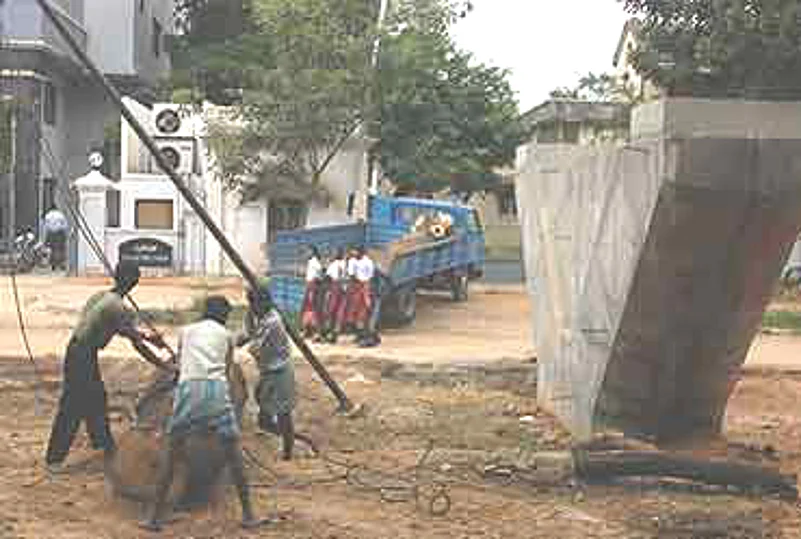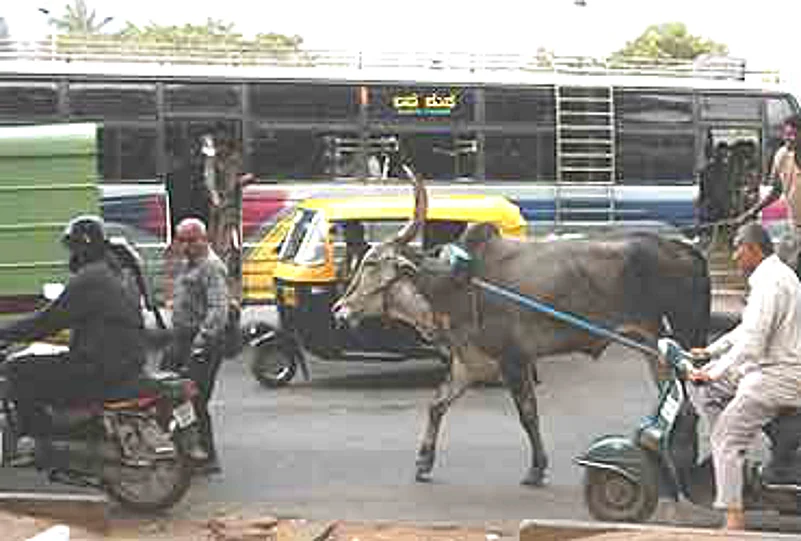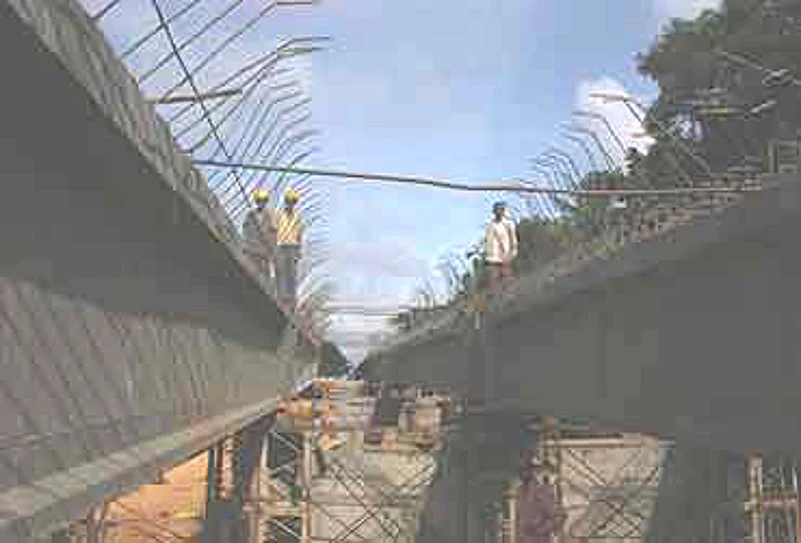"Garden city, garden city of what are your gardens made?" It is a rhetorical question that jumps out of a smart publicity copy for a jewelry shop in Bangalore. If Bangaloreans were to answer this question even a decade ago, they would have probably listed everything from Alexandria Laurels, Arjunas, Amaltas, Bohemias to Copper Pods, Champaks, Parijathas and the ubiquitous Gulmohars. Ask them today as to what is in theircity and they are sure to yell: traffic and chaos!
In fact, the theory making the rounds is that the most recent sobriquet of 'Silicon Valley' that the city wears has submerged and not complemented its earlier titles of a 'Garden City' and a 'Pensioner'sParadise'. The origins of this theory is traced to, surprisingly, South Bangalore, the home of the upwardly mobile middle class that benefitedthe most from the city's boom and avant garde position in information technology. Infosys' N R Narayana Murthy belongs to this part of the town and Infy made its humble beginnings in Jayanagar, the nerve-centre of South Bangalore.
Advertisement

Most recently, the 'Southerners' heckled against a flyover that completely overshadows their 90-year-old alma mater, National College (among the many illustrious alumini of this college are three great Indian spinners EAS Prasanna, B S Chandrashekar and Anil Kumble), and uprooted nearly a 100-year-old Vani Vilas Circle with magnificent chandelier lampposts, inBasavangudi. Most walkers who love the serene tree-lined calm of the road, typical of old Bangalore, which touches the century-old Ramakrishna Math and leads to the gates of the renowned botanical gardens, Lal Bagh, argued that the road was their common heritage and was being sacrificed to something "as ridiculous" as traffic. A 100 years for a city like Delhi may be nothing, but, for a young 467-year-old city,it is quite a chunk and holds the key to the civilisation clues of the place.
The battle cry against traffic is not confined to South Bangalore alone but is spread across the city. And the cry gets more shrill as residents see markers of their city's character and history getting demolished even while there is no sign of traffic reducing. "Like in the case of all emerging cities, it is a difficult choice between retaining the past and meeting the necessities of the present," says Suresh Moona, a historian of the city. According to the Transport Department an average of 650 to 700 vehicles get registered in the city per day and currently there are 19,81,589 vehicles plying on Bangalore's roads.
Contrast these figures with the almost forgotten Bangalore Development Committee Report presented by thevisionary retired Dewan of Mysore, Madhava Rau, in 1954. The report which spoke of Greater Bangalore and an outer ring road for the first time projected a population of 14,14,000 for the city by 2001 at 12.5 per cent increase per decade. His projection for 2031 was 20,00,000. A gross underestimation, you may say, if presented with today's population figures of 65,23,110. When the report was written, there were just about 8535 motor vehicles in the city. Nothing more needs to be said about Bangalore's rapid transition into chaos and most of it has happened in the 1990s. "Since the transformation of the city has taken place at the speed of an e-mail, people think that before they could bat an eyelid the most familiar things that they identified with the city's character are gone," says Veena Shivraj, an engineer from Bangalore who lives in Santa Clara.
What are these familiar things for Bangaloreans is a long list. But here are a few that would strike a chord with many:
Let us begin with some 70 to 100-year-old traffic islands that had to be done away with toaccommodate smoother movement of traffic. Hudson Circle that recalled the contribution of educationist and missionary Joshua Hudson was removed; Irwin Circle that was built to commemorate the visit of viceroy Lord Irwin to the city was done away with, apparently Lord Irwin was so happy with Bangalore's development that he waived off a huge loan that the Mysorestate owed the Imperial government; Inayatullah Mekri Circle built in 1937 was sacrificed for an underpass in North Bangalore, the carved name plaque was carelessly thrown only to be restored to an obscure corner after the family protested; the most famous Vani Vilas circle that was witness to the Mysore Chalo agitation in 1946 and Mahatama Gandhi's visit; Shoolay Circle; Richmond Circle; Bhasyam Circle in Sadashivanagar and Krishna Raja Circle that were demolished were equally old.
Advertisement

Why do Bangaloreans croon about traffic islands? That is because they were dominant symbols of the city's idea of leisure. And leisure was the city's USP in the pre-IT days. The circles sat pretty in the middle of traffic intersections and they had gardens that had flowers. Historian Suresh Moona adds that these old circles had remarkably designed chandelier lampposts which were specially commissioned by Sir Mirza Ismail to celebrate the 25 years of administration of the Mysore king Krishna Raja Wodeyar. "Half of the Silver Jubilee Park that was built on the same occassion that ran from K R Market to the Town Hall has also been swallowed by the Sirsi Circle flyover. Sir Mirza's Oval has also lost its character because of the gigantic flyover," laments Moona.
After traffic islands, we have to reckon with the huge ancient trees that made Bangalore famous for its salubrious climate and gave it a garden city status. According to S G Neginhal, former Forest Service officer and author of a definitive book, City Trees and Urban Planting, nearly 400-500 year old Banyan, Mohwa, Tamrind and Ashwath trees on highways that connect the city were pulled down to broaden the roads for traffic. Also, a good number of the million trees that were planted between 1982 and 1987 inside the city under the Green Belt project have been felled for wider roads.
Now a whole line of 100 to 200-year-old trees on Sheshadri Road will be lost when the Anand Rao Circle flyover close to the Bangalore Turf Club will come up. "The traffic in the Anand Rao circle area was always heavy, but the place remained cool because the trees arrested the solar radiation, if the trees go the place will hot up" says Neginhal.
If this is the fate of felled trees, the lives of ones that survive are not very secure. During the monsoon storm and rains in the city, not Cyclonic in proportions, hundreds of trees on pavements just crumbled on vehicles and people standing below them. "This is because while widening roads and modernising footpaths they cut off the side roots and surface-feeder roots that are so very important to anchor the tree. Also the telephone and electricity departments prune only one side of the foliage which upsets the tree canopy and makes it top heavy," reasons Neginhal. "If trees are lost, every bit of our heritage is lost, Bangalore will become a desert city," he warns.

The new flyover near Ananda Rao circle, like the one coming up near National College, has become a controversial one. What bolsters the case against this flyover is that it badly affects another city heritage marker, the nearly 90-year-old Bangalore Turf Club (BTC). A magnificent lung space in the City central that complements Cubbon Park, Lal Bagh and the High Grounds golf course. The proposed flyover is expected to eat away 3000 square feet of the club, that is about 150 stables will be lost. But the hard reality about Ananda Rao circle is that peak time traffic averages at 15,125 passenger car unit(PCU) and that makes it one of the busiest traffic junctions in the city, according to a report.
Advertisement

Just a few paces down the Sheshadri road from Ananda Rao Circle stood the Central Jail built in 1867 where freedom fighters were hanged. The jail also hosted top political leaders during the Emergency. It has now been shifted out to the outskirts of the city, but the huge space has been retained for a proposed Freedom Park. But people in the surrounding area wonder as to what will happen to the Park plan if such an imposing flyover comes up close by.
The Bangalore Chapter of Intach, which is restoring a lot of heritage buildings in the city has a more alarming presentation. Convenor H R Pratibha says: "The fountain in front of the town hall (a 70-year-old Greecian structure close to the Sirsi flyover) was removed to accommodate traffic and the building had earlier been acid-washed 8 to 10 times to remove carbon and dust deposits and this has affected the bonding and in turn the strength of the building. The surface of the Vidhana Soudha is also damaged due to a couple of acid washes, but with great difficulty we saved the colonial Mayo Hall from dilapidation. But the court building in the corner is badly damaged because traffic moves very close and the vibration is severe."
But the worst fear for Bangloreans is the expansion of the Avenue Road one of the two principal intersecting roads that was created at the time of the city’s birth in 1537 and the commercial hub of Old Bangalore. Expansion plans have been stopped twice, once during the time of Sir M Visvesvaraya and later Devaraj Urs. But shopkeepers, whose ancestors have carried on business here for centuries fear that expansion would become imminent.
One of the most shocking incidents that took place recently in the city that exposes traffic pressures and the insensitivity of the police was when a huge granite and steel sculpture, ironically symbolising growth and energy, of renowned sculptor Balan Nambiar on Lavelle Road right behind the Bowring Club, installed in 1986, was removed overnight and thrown away. The police have not been able to trace it to date.
With the removal of the traffic islands, felling of trees and construction of flyovers, has the city’s traffic situation eased? For the record, there are five flyovers operational now, two underpasses, one cable-stayed bridge and eight more flyovers are in the process of construction in the city. There is also an inner ring road, outer ring road and the third peripheral ring road is being planned. Inspite of this, traffic police officials admit that they are not even close to a solution for the city’s traffic. "On any given day, peak hour traffic volumes in Bangalore Central averages at 10,000PCU. To keep the traffic flowing we have converted 45 major roads of the city into one-ways. Also, most roads are too narrow, we have only a couple of 100 feet roads," says an official source in the traffic commissioner's office.
The most damning fact about Bangalore’s traffic comes out when Dr. N K Venkataramana of the Comprehensive Trauma Consortium (CTC), which offers pre-hospital care, says that since they began in 2002 they have not been able to attend about 402 calls, that is shift victims from accident or medical emergency spots due to traffic jams. On an average they miss 15 such calls a month, he adds.
With all these facts staring into every Bangaloreans face, whatever happens to former chief minister S M Krishna's dream of making a Singapore out of Bangalore? As a retired bureaucrat puts it Bangalore should have taken a cue from European cities, "then, there would have been space for both old and new," he says.



















